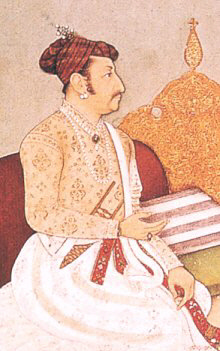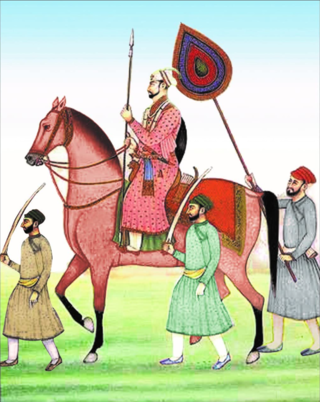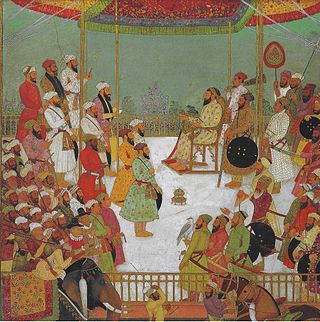
Mirza RajaMan Singh I was the 24th Maharaja of Amber from 1589 to 1614. He also served as the Subahdar of Bengal for three terms from 1595 to 1606 and the Subahdar of Kabul from 1585 to 1586. He served in the Imperial Mughal Army under Emperor Akbar. Man Singh fought sixty-seven important battles in Kabul, Balkh, Bukhara, Bengal and Central and Southern India. He was well versed in the battle tactics of both the Rajputs as well as the Mughals. He is commonly considered to be of the Navaratnas, or the nine (nava) gems (ratna) of the royal court of Akbar.

Faujdar under the Mughals was an office that combined the functions of a military commander along with judicial and land revenue functions. However, the term faujdar contained pre-Mughal origins. During those times, the term referred to a military officer but did not refer to a specific rank. With the administrative reforms performed by Mughal emperor Akbar, this rank was systemised. It constituted an independent administrative unit and its territorial limits varied from place to place and from time to time.
The Singranatore family is the consanguineous name given to a noble family in Rajshahi of landed aristocracy in erstwhile East Bengal and West Bengal that were prominent in the nineteenth century till the fall of the monarchy in India by Royal Assent in 1947 and subsequently abolished by the newly formed democratic Government of East Pakistan in 1950 by the State Acquisition Act.

Raja Raisal, reigned 1584 to 1614, He married Chauhan Rajput Princess Kisnavati Nirban, the only daughter of Raja Peetha Nirban of Khandela and thus, was also the 1st Shekhawat Raja of Khandela. Son of Maharao Suja of Amarsar, was granted the estate (jagir) of 7 villages in Lamiya on death of his father, thereupon he joined Imperial Service at Delhi where he was granted the title of "Raja" also a title of "Darbari" and a Mansab of 1250 sawars which was later raised to 3000 by Emperor Akbar. He died about 1614 in South India. He was great-grandson of MahaRao Shekha, King of Amarsar and he belonged to the Kachwaha Clan of Amber/Jaipur Royal Family. The Shekhawats ruled over the Shekhawati region for over 500 years and are honoured with the hereditary title of "Tazimi Sirdars", whom the Maharaja of Jaipur receives by rising from his seat.

Amiral Kabir Sayyid Mahmud Khan Barha, also known as Mahmud Khan and mahmud dewaan, was a general in the Akbar's army, son of Sayyid Mubarak, was the first person of this family - the Sayyids of Barah - to rise to the rank of a nobleman. This he did through his bravery and valour during the Timurid dynasty. He joined the service of Bairam Khan.

Abu'l-Fath Jalal-ud-din Muhammad Akbar, popularly known as Akbar the Great, and also as Akbar I, was the third Mughal emperor, who reigned from 1556 to 1605. Akbar succeeded his father, Humayun, under a regent, Bairam Khan, who helped the young emperor expand and consolidate Mughal domains in the Indian subcontinent.

Shahrullah Kamboh, better known as Shahbaz Khan Kamboh, was one of the leading generals of Mughal emperor Akbar. He participated in some of the most difficult expeditions of Akbar and annexed numerous territories to the empire. He was too orthodox a Sunni Muslim for Akbar's taste, but not only was he tolerated but also was greatly valued. He was named “Mang Khan” by the people of Lahore meaning “ask the Khan and it will be done” In Punjabi due to his legendary generosity. The very first ‘guzar’ in Lahore Fort was named Guzar Shahbaz Khan known locally as Guzar Mang Khan.
Qasim Khan Juvayni was a Mughal general and nobleman of the court of Mughal emperors Jahangir and Shah Jahan. He also served as the Subahdar of Bengal, succeeding Fidai Khan, from 1628 to 1631. He is most notable for the capture of Hugli off the Portuguese firingis.

Mirza Khujista Akhtar Jahan Shah was the fourth son of Emperor Bahadur Shah I. The birthdate of Mirza Khujista Akhtar Jahan Shah is debated, according to his found memoir his death date is now set on 1730. Both dates are correct otherwise then.
Aphariya (Abhirya) also spelt as Affariya, Afariya or Phariya) is a clan of Yaduvanshi Aheer or Yadava. Aphariyas ruled the Ahirwal state of Haryana.
Islam Khan V was one of the prominent Emir and nobleman during the Mughal empire. He was titled "Islam Khan" and "Barkhurdar Khan" by Emperor Bahadur Shah I and held many important posts during the successive rules of Bahadur Shah I, Jahandar Shah, Farrukhsiyar, Rafi ud Darajat, Shah Jahan II and Muhammad Shah.

The Army of the Mughal Empire was the force by which the Mughal emperors established their empire in the 16th century and expanded it to its greatest extent at the beginning of the 18th century. Although its origins, like the Mughals themselves, were in the cavalry-based armies of central Asia, its essential form and structure was established by the empire's third emperor, Akbar. The army had no regimental structure and the soldiers were not directly recruited by the emperor. Instead, they would be recruited and fielded by Mansabdar officers.
Raja Desingh or Raja Tej Singh was a king of the Bundela Rajput who ruled Gingee in 1714 CE.

Gaj Singh Rathore was the Raja of Marwar kingdom.

Sawai Raja Soor Singh or Suraj Mal or Suraj Singh, was the ruler of the Rathore Kingdom of Marwar .His sister Manawati Deiji/Bilqis Makani was the consort of Mughal Emperor Jahangir and mother of his successor Mughal Emperor Shah Jahan.

Khan Dowran VII, was an Mughal statesman and general in the eighteenth century. Originally Khwaja Asim, he was made Samsam ud-Daula Khan-i Dauran and was the Mir Bakshi and Amir-ul-Umara. He was the head of all the imperial nobility and the commander-in-chief of the Mughal army during the reign of Muhammad Shah, and served the Emperor until his death at the Battle of Karnal.
Raja Kishan Singh was the son of Mota Raja Udai Singh of Marwar and the founder of Kishangarh. His sister Manawati Deiji was the wife of Mughal Emperor Jahangir and mother of fifth Mughal Emperor Shah Jahan.

Sa'adullah Khan also spelled Sadullah Khan was a noble of the Mughal Empire who served as the last grand vizier of Emperor Shah Jahan, in the period 1645–1656. He was considered among the four most powerful nobles of the empire during Shah Jahan's time.

Khwaja Sabir, Nasiri Khan or Khan-i-Dauran was an Indian Muslim viceroy of the Deccan and one of the Mughal emperor Shah Jahan’s leading sardars. He received the title "Khan Dauran" during the conquest of Daulatabad. He died in Lahore in 1645 from a knife wound from his own attendant, a Kashmiri Muslim. He hald the rank of 7,000 horse.

The Bakhshi in the Mughal Empire denoted a number of hierarchical government officials, typically involved with military administration and intelligence. The offices were introduced during the reign of Mughal emperor Akbar. Bakhshis were found in both the central and provincial administration; the most notable kind of bakhshi was the mir bakhshi, one of the empire's four ministers, broadly in charge of administering the mansabdari system. Along with the wazir, the mir bakhshi was one of the leading officials of the empire.













